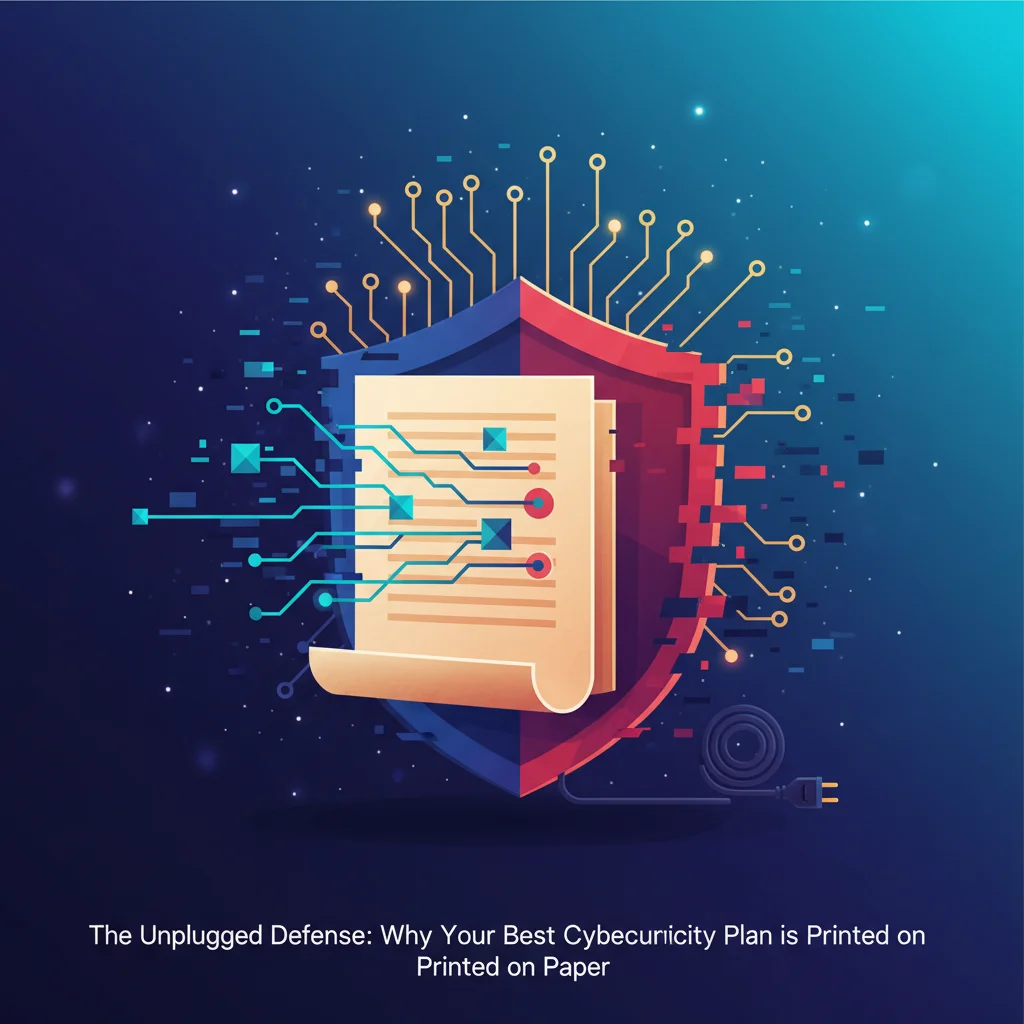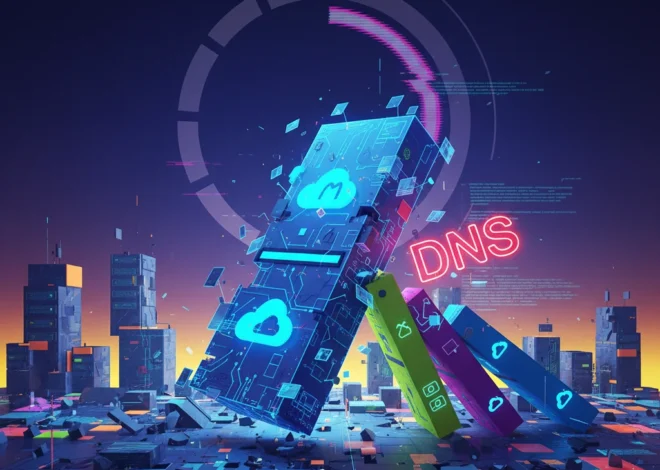
The Unplugged Defense: Why Your Best Cybersecurity Plan is Printed on Paper
Imagine this: It’s 3 AM on a Tuesday. Your phone buzzes relentlessly. It’s your lead developer. Then your head of operations. A single, chilling message flashes across your screen from a blocked number: “Your network is ours. Your data is encrypted. Pay up or it’s gone forever.”
You try to log in. Nothing. Slack is down. Your cloud servers are unresponsive. The customer database, your project management tools, your entire company’s digital brain—all inaccessible. Your incident response plan, carefully crafted and stored on the company’s shared drive, is just as encrypted as everything else.
Panic sets in. What do you do? Who do you call? How do you even begin to fight back when all your tools are gone?
This scenario isn’t a Hollywood script; it’s a terrifying reality for thousands of businesses every year. In our hyper-connected world of sophisticated software, ubiquitous cloud services, and AI-driven automation, we’ve built digital fortresses of incredible complexity. Yet, as a recent advisory from the BBC highlights, the most critical fail-safe in the event of a total breach isn’t a more advanced algorithm—it’s a stack of paper. The advice is starkly simple: prepare to switch to off-line systems and have your plans printed out (source).
It sounds almost laughably low-tech, but in the face of a modern cyber-attack, an analog plan is your last and best line of defense. Let’s explore why this “unplugged” strategy is more critical than ever for everyone from startups to established tech giants.
The Illusion of Digital Invincibility
Modern businesses run on a symphony of interconnected digital services. We rely on SaaS platforms for everything from accounting to customer relations. Our infrastructure lives in the cloud, offering incredible scalability and flexibility. We leverage artificial intelligence and machine learning to optimize operations, analyze data, and even bolster our cybersecurity defenses. This intricate web of technology creates an illusion of a seamless, resilient, and always-on operation.
But this interconnectedness is also a liability. A single compromised credential can provide a threat actor with the keys to the entire kingdom. The very automation that streamlines our workflow can be turned against us to propagate malware at lightning speed. The complexity of our systems creates a vast attack surface, with countless potential vulnerabilities for attackers to exploit.
The attackers themselves are evolving. They are no longer just lone hackers in basements. They are sophisticated, well-funded organizations using their own AI and machine learning models to identify vulnerabilities, craft convincing phishing emails, and automate attacks on a massive scale. The result? The cost and frequency of data breaches are soaring. According to a 2023 IBM report, the global average cost of a data breach reached an all-time high of $4.45 million, a 15% increase over 3 years (source). For small businesses and startups, such a cost can be an extinction-level event.
When the Screen Goes Black: The Anatomy of a Digital Shutdown
When a severe cyber-attack like ransomware strikes, it’s not just about data being stolen; it’s about a complete operational shutdown. The fundamental tools you use to run your business and coordinate a response vanish in an instant.
- Communication Breakdown: Email servers are down. Slack or Microsoft Teams is inaccessible. How do you contact your incident response team, your legal counsel, or your employees? How do you warn them not to log in?
- Loss of Institutional Knowledge: Where is that critical server password stored? In a digital password manager that you can no longer access. What are the steps to restore the database? The instructions are on the now-encrypted company wiki.
- Inability to Act: Your digital incident response plan is a useless file on a locked-down server. You know you have cyber insurance, but the policy number and contact information are in your encrypted files. The digital-only approach creates a paralyzing catch-22.
In this moment of chaos, your team is flying blind. The goal of a sophisticated attacker is not just to encrypt data but to induce panic and cripple your ability to respond, forcing you to make a desperate choice: pay the ransom or face collapse.
Building Your Analog Ark: The Core of an Offline Response Plan
An offline incident response plan is more than just a document; it’s a physical toolkit for survival. It should be stored securely in multiple off-site locations, accessible to key personnel without needing network access. Think of it as your company’s emergency “go-bag.”
Here are the essential components your printed plan must include. This table breaks down what you need and why it’s critical.
| Component | Description & Purpose |
|---|---|
| Emergency Contact Roster | A printed list of names, personal phone numbers, and alternative email addresses for key personnel (exec team, IT/security, legal, PR, HR), third-party vendors, cyber insurance provider, legal counsel, and law enforcement (e.g., local FBI field office). This is your command-and-control communication network. |
| Role-Based Action Checklists | Simple, step-by-step checklists for specific roles. What are the first five things the CEO must do? The lead engineer? The head of communications? This prevents confusion and ensures critical first steps aren’t missed in the panic. |
| Network & System Diagrams | Architectural diagrams of your network, servers, and cloud environment. This helps the response team understand what they’re dealing with, identify critical assets to isolate, and plan the recovery sequence. |
| Backup & Recovery Procedures | Detailed, unambiguous instructions on how to access and restore from your offline or air-gapped backups. This includes locations, credentials (stored separately and securely), and the exact technical commands required. Don’t assume your team will remember this under pressure. |
| Pre-Approved Communication Templates | Drafts of internal announcements, customer notifications, press statements, and social media posts. Having these pre-vetted by legal and PR teams saves precious time and prevents disastrous miscommunication during the crisis. |
| Evidence Preservation Guidelines | Simple instructions on how to preserve forensic evidence for law enforcement and insurance claims. This can include guidance on not rebooting compromised machines and documenting every action taken. |
Modern Tech’s Role in an Analog Defense
Having a paper plan doesn’t mean shunning technology. In fact, you should use modern tech to make your analog plan more effective. The goal is to use today’s tools to prepare for a moment when those tools might not be available.
This is where innovation in cybersecurity truly shines. Advanced AI and machine learning algorithms are no longer just for attackers; they are the core of modern threat detection systems. These platforms can analyze network traffic, identify anomalous behavior, and flag potential threats long before a human analyst could, drastically reducing the odds you’ll ever need to pull that binder off the shelf. According to a study by Capgemini, AI-powered cybersecurity measures can help organizations identify and respond to threats up to 60% faster (source).
Furthermore, automation can be used to run “fire drills.” You can automate simulations of a network outage to test your team’s ability to execute the offline plan. Did they know who to call? Could they find the necessary documents? These drills reveal gaps in your paper plan before a real crisis does.
For developers and those in programming, this means building resilience from the ground up. It’s about more than just writing secure code; it’s about architecting systems that can fail gracefully and be recovered systematically. This includes implementing immutable backups in your cloud storage—backups that, once written, cannot be altered or deleted for a set period, rendering them impervious to ransomware encryption.
A Tale of Two Startups
Consider the divergent fates of two hypothetical tech startups, “InnovateFast” and “BuildRight,” both hit by the same ransomware strain.
InnovateFast was a classic “move fast and break things” company. Their incident response plan was a 20-page Google Doc. When the attack hit, their entire Google Workspace was encrypted. They had no access to contacts, procedures, or plans. The team descended into chaos, communicating via a fragmented WhatsApp group. They wasted 72 critical hours just trying to figure out what to do. The financial loss from downtime and the reputational hit from their panicked, chaotic response ultimately proved fatal. They folded six months later.
BuildRight, on the other hand, had a culture of pragmatic paranoia. Their CTO insisted on maintaining and regularly updating a physical “Red Binder.” When they were hit, the CEO grabbed his copy from his home safe. The team convened on a pre-determined conference bridge (number listed in the binder). They executed their roles flawlessly, isolating systems, contacting their insurance provider, and deploying a pre-written statement to customers within three hours. They were able to restore their systems from air-gapped backups and were back to 80% operational capacity within 48 hours. They survived, and their transparent, efficient handling of the crisis actually earned them customer trust. The impact of data breaches on small businesses is profound, with nearly 60% of small companies going out of business within six months of a major attack (source). Preparation is survival.
Conclusion: Your Strongest Defense is Your Simplest
In the relentless pursuit of technological advancement, it’s easy to forget the power of simple, robust solutions. An offline, paper-based incident response plan isn’t a nostalgic relic; it’s a vital, modern strategic tool. It’s the ultimate acknowledgment that digital systems, no matter how well-architected, can fail.
Building this plan isn’t a one-time task. It requires regular review, practice drills, and a company-wide commitment to a culture of resilience. It’s about empowering your team to act decisively in the worst-case scenario.
So take a moment today. Look away from your screen and think about what you would do if it never turned back on. Then, go to the printer. Your company’s future might just depend on it.


